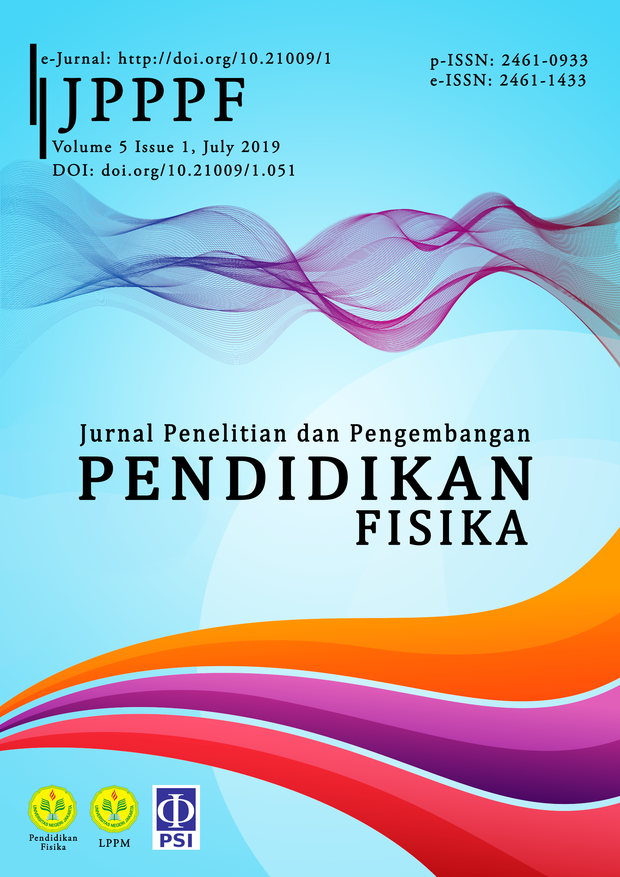Online Web-Based Learning and Assessment Tool in Vocational High School for Physics
DOI:
https://doi.org/10.21009/1.05101Keywords:
web-based assessment, computer assisted learning, physics learning, student feedbackAbstract
ICT has transformed the conventional learning system into a modern learning system, demanding innovation in the delivery of learning. So that this study has the aim of developing, knowing the feasibility of online web-based learning and assessment tool in physics, as well as knowing students' learning results in the ICT media. This study research & development (R&D) method using Borg & Gall model. Which refers to the potential problem through data collection, product design, design validation, revision of product design, product testing, revision of usage. The feasibility testing of media and material was carried out by two material expert validators and two media expert validators with a small group trial conducted on students consisting of 13 respondents and large group trial conducted on students consisting of 40 respondents. We use online media for web-based learning and assessment tool in vocational high school for Physics subject, and the results of the study show that this application generates individual assignments, marks student responses, supplies students with the rapid feedback, and records student activities. The student activity log provides insight into student learning habits. Its a reference for assessment. This application meets the requirements as a learning media. The results of the validation by an expert material on online web-based learning and assessment tool gets a percentage of an average score of 82%, and the material gets a percentage of 81.33% criteria very feasible.
References
Bawaneh, S. S, 2011, The Effects of Blended Learning Approach on Students’ Performance:Evidence from a Computerized ccounting Course. International Journal of Humanities and Social Science, 1 (6), 63–69
Brekke,M,& Hogstad,P,H, 2010, ‘Potret New Teaching Method-Using Computer Technology in Physics, Matematics,and Computer Sains’ . iJEP, Vol. 6 , pp. 53-59.
Drigas A, S & Theofania,M, 2016, ‘ICTs Based Physics Learning’, Institute of Information and Telecommunications, vol. 6,Issue 3, pp. 53-59.
Fauzi, Ahmad. 2016. ‘Potret Penggunaan Tik oleh Guru Sekolah Menengah Atas (Sma) Untuk Menanamkan Keahlian Literasi Siswa Dalam Mendukung Pembelajaran Fisika’ Jurnal Profesi Pendidik ‘ Vol. 3 Nomor 2 , pp. 107-113.
Habibi, Z & Habibi,A, 2014,‘The Effect of Information Technology in Teaching Physics Courses’, The Eurasia Procedings of Educational & Social Sciences (EPESS), vol. 1, pp. 391-396.
Husamah. 2012. Pengembangan E - Learning Ekologi Tumbuhan Untuk Meningkatkan Kualitas Pembelajaran Dan Kompetensi Peserta Didik. Laporan hibah pengajaran dia - Bermutu. Malang: Prodi Pendidikan Biologi Fkip Umm.
Jarosievitz, B, 2012, ‘ICT in Physics Teaching for Secondary School and Colleges’, Researchgate, vol. 39, pp. 1-6.
Kallating, S, Serevina, V, & Astra, I,M, 2015, ‘’,Jurnal Penelitian & Pengembangan Pendidikan Fisika, Vol. 1 No1, pp.1-8.
Kusyeni, Mery, 2017, ‘Pengembangan Media Pembelajaran Blended Learning Berbasis Edmodo di Sekolah Menengah Kejuruan Kelas XI pada Materi Gelombang’, Skripsi, , pp. 67-69.
Prasetya, D,D,Rahmawati,Y, & Widiyaningtyas, T, 2010, ‘’Konferensi Nasional dan Workshop APPI’, Vol. 1 No1, pp.1-8.
Quijada, R 2015, ‘Information and Communication Technology (ICT) in Physical Education a Theorical Review’, Scientific Technical Journal, vol. no I , pp. 75-86.











